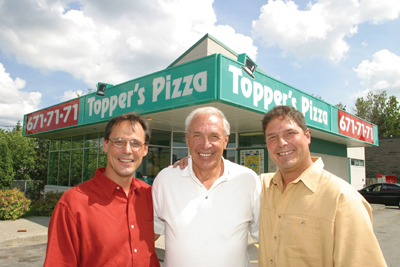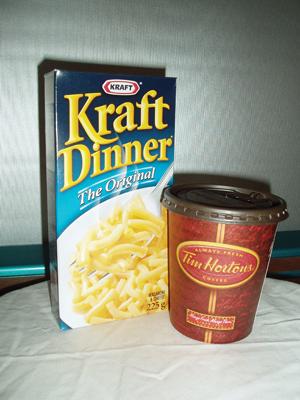
Branding the Franchise
By Keith Toppazzini
Features Business and Operations MarketingArguably the most challenging factor
Sometimes being a fly on the wall can hurt!
Sometimes being a fly on the wall can hurt!
 Keith Toppazzini – "A company must find new ways to improve its brand-awarenenss." (Left to right) Keith, Ron (founder) and Kelly Toppazzini. Keith Toppazzini – "A company must find new ways to improve its brand-awarenenss." (Left to right) Keith, Ron (founder) and Kelly Toppazzini. |
During Topper’s initial expansion into the southern-Ontario market, I recall standing outside the construction site of one of our stores. Two women walked by pushing baby strollers. One woman commented as she read the Another Topper’s Pizza Opening Soon posters on the window. “That’s just what we need – another pizza joint!” That comment struck hard. I certainly believed that we had a reputation of being anything but just another pizza joint. I wanted to offer her a sample of our pizza and quickly change her mind but that wasn’t possible – the ovens were being installed the following week!
Arguably, there are many challenges facing a franchise chain and this topic would start an interesting debate in a room of franchisors. I believe that the most challenging factor franchisors will face is establishing their brands. Established brands even continue to go through these same challenges when entering new and foreign markets.
When a consumer associates a logo with a perception of the product or service, the process of branding has begun. When all consumers have the same associations and perceptions, the process is successful. The ultimate goal is that your brand replaces the word for an industry product or service. My children call macaroni and cheese ‘Kraft Dinner’ regardless of the brand they’re eating. People don’t ‘courier’ anymore; they ‘FedEx’. When en route to a construction site, our contractor always says “You better bring Tim’s for the boys.” ‘Tim’s’ has replaced the word ‘coffee’ in most parts of Canada.
Just the other day I coughed around my youngest daughter and she quickly blurted out “Robitussin.” I got the same response from my nephew. Later that evening I was watching a cough medicine commercial on TV. An actor coughed and another actor replied “Robitussin.” The commercial explained that this was “Bless you!” for a cough. Now that’s branding!
So how did these companies create such powerful brands? How does coffee become a ‘Tim’s’ and macaroni become Kraft Dinner? The process begins with trial – lots and lots of trial. I go to sporting events with my children and one thing I can always count on is seeing a big, brown coffee dispenser bearing that famous and urge-inducing Tim Horton’s logo. Free coffee is usually being doled out to eager volunteers or parents unaccustomed to attending swim meets at seven in the morning.
Branding begins with one of the most effective ways of promoting trial of a new product: offering free samples to customers. If the goal is to get and keep more customers, then the strategy is to offer as much trial as possible. The hope is that the customer loves your product so much that he or she can’t live without it. Grocery stores have been offering deli samples for years. Consider Costco. You could feed a family of four just walking up and down the aisles on a Saturday. Perfume stores and ice cream shops, even the LCBO is active in offering samples of new product. I never imagined that I’d see people doing shooters at the liquor store, but here we are.
The objective here is to create an association between the sample and your brand. It’s not good enough to send out packets of shampoo and have your customers believe it’s the best shampoo they’ve ever used. They have to know where it came from. That shampoo has to arrive in the same style of packaging, wearing the same labels as the product sold in stores. Otherwise Mrs. Consumer will become confused and take her business elsewhere.
By giving away your product, you essentially accomplish three things: firstly, you begin the branding process through customer trial (and eventually brand/product association). Secondly, you demonstrate support for the community, and thirdly, you create one more instance when a customer will try your product and not someone else’s. It’s highly unlikely that a volunteer will order pizza from the competition after spending the day enjoying yours. This kind of support can effectively begin brand-domination in your market.
But don’t wait for someone to approach you. Seek out opportunities. Your customers’ perception of you and your generosity all lend to the same result. As well, a regular in-store product sampling program can have a great effect We often offer free slices of pizza and breadsticks, either when we launch a new menu item or as a way saying ‘thanks’ as customers wait for their orders. This is our way of saying thank you to our loyal customers who return often and, hopefully, recommend us to others.
Every company that has succeeded in branding has had some help along the way and that help comes from its staff. The team members of any company are pivotal. Every team member that customers come in contact with is part of the branding process. It only takes one moment to define that experience and you need to manage that moment. Effective branding requires internal communications to be consistently clear and concise, training to be ongoing, and standards strictly adhered to.
The team delivers the message of the brand, and with this in mind, the company must first make certain that the team understands that message. Only when the company and the team are parallel in this understanding can the message be delivered to the customer. Conducting employee surveys does an effective process for confirmation of your team’s understanding.
There are different ways of creating this culture in your business. Some companies use in-store signage, memorandums, newsletters, workshops, and corporate events. You need to discover a way that works for you. And if you can’t, hire someone to do it for you.
I find it ironic that I was asked to write this article when my brother and I had just spent the previous few days meeting with advertising agencies discussing this very topic. It leads me to my next point. A company must find new ways to improve its brand-awareness and will often seek the assistance of professional marketers.
Professionals will help create very consistent and meaningful messages that you can advertise repeatedly. In fact, repetition is a very effective form of advertising your brand. A company trying to establish a quality brand cannot advertise deep discounts. The words ‘quality’ and ‘cheap’ simply don’t belong together. Instead, it must communicate how its product is superior. This message is created in a ‘box’ of sorts. This box is a documented set of parameters that keeps the message from straying and damaging the brand. It’s a list of do’s and dont’s. Some companies manage this internally, but the approach is usually somewhat the same.
Public relations are a great alternative to advertising. Companies have found the ‘free advertising’ approach more rewarding and have successfully created branding through word-of-mouth. Consider an ‘advertorial’: part advertisement, part editorial. Advertorials in magazines or newspapers deliver positive and meaningful messages while creating the perception that they’re coming from an unbiased and trustworthy third party. This approach is highly effective in creating a ‘buzz’. Readers tend to place more confidence in an advertorial because it looks like a news article.
Whatever your approach, manage the messages coming from your business at every point – through product trial, your team members, advertising – every point. Your customer has no patience for confusion.
 Powerful branding can Powerful branding can turn coffee into a ‘Tim’s’ and macaroni into Kraft Dinner. |
There is no doubt that branding is the final measurement of a company’s performance over time. As a company, all of the efforts from every team member and department funnel into the brand and as a result, the customer’s perception is complete. With this in mind, it is vital that a company monitor its progress through measurements. Although it is common for most companies to measure many areas of their performance, the customer experience is sometimes overlooked.
Monitor your progress through customer surveys. Ask very specific questions that you feel will define your brand. Was this product everything you expected? Was it served to you properly? (and most importantly) Would you recommend us to your family and friends? Our online customer survey asks customers to police our business. Most customers are too willing to talk about their experiences. And that’s great. Listen when your customers tell you how you’re doing.
In the end, the customer experience will be the final measurement of any brand, and at our company, CEO stands for Customer Experience Officer.•
by e-mail at info@toppizza.com.
Print this page